
Key Takeaways
- Dust often comes from indoor sources like paper particles, cooking residue, tracked-in dirt, and pet dander.
- Outdoor dust sources include pollen, wind-blown soil, dirt on shoes, and vehicle exhaust.
- To reduce dust, clean and replace HVAC filters regularly, and vacuum your home regularly.
Despite your best efforts to maintain cleanliness, dust always seems to find its way into your living space, leaving you wondering, “Why is my house so dusty?”
But before you blame your cleaning skills, consider that there are a multitude of factors contributing to the constant dust accumulation. Whether it’s dirty air filters, pollen, or pet dander, the sources of dust are quite diverse.
This comprehensive guide aims to help you regain control over your never-ending battle with dust. It explores the primary culprits behind relentless dust build-up and provides effective solutions to manage them.
What Is Dust & Where Does It Come From?
Dust consists of minuscule solid particles floating in the air or lying on surfaces. These particles are of different sizes and compositions. Dust can originate from both outdoor and indoor sources. The tiny size of dust particles allows them to remain in the air, leading to their widespread distribution and buildup in different environments.
Indoor sources of dust include:
- Humans and pets shed dead skin cells.
- Fibers from textiles such as carpets, upholstery, and clothing.
- Paper and cardboard particles from books, magazines, and packaging materials.
- Cooking residue and food particles.
- Soil and dirt tracked in from outdoors.
- Insect debris, including dead insects and their waste.
- Pet dander and fur.
- Particles from smoking or burning candles.
Outdoor sources of dust that can infiltrate indoor spaces include:
- Pollen from plants and trees.
- Soil and dirt particles carried by wind or on footwear.
- Pollution and industrial emissions.
- Vehicle exhaust and road dust.
- Construction and landscaping activities.
Common Reasons for Dust In Your House
Dust accumulation in your home can be attributed to multiple factors, such as:
1. Dirty Air Filters
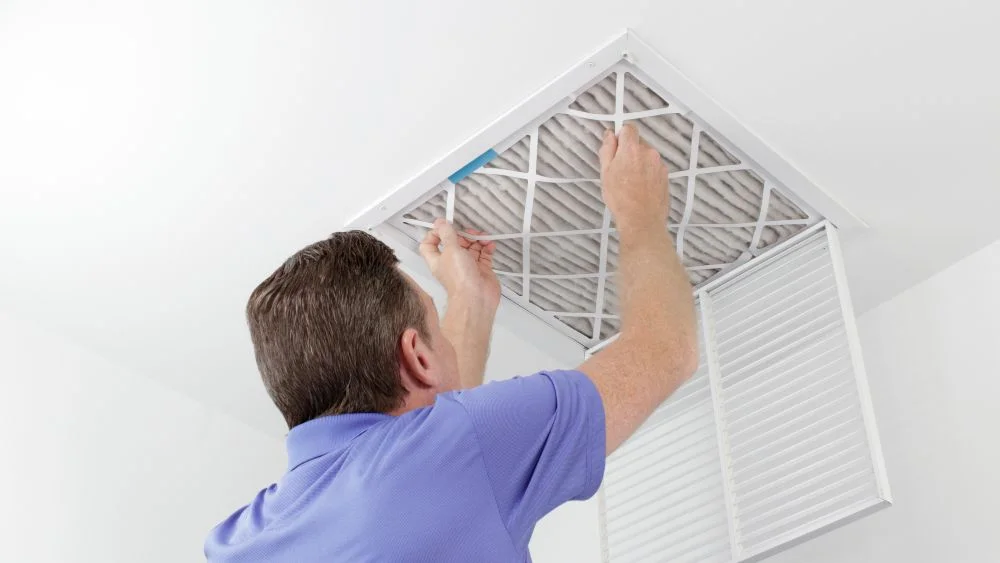
The air filters in your HVAC systems block dirt and debris circulating in your space. However, if you haven’t cleaned or changed them in a while, they cannot prevent dust particles from entering your home.
In addition to maintenance, choosing the right type of filter is also important. Poor-quality air filters have bigger gaps, which means they can’t effectively trap dust. This dust can then circulate back into your home through the supply vents.
Air filters are graded on a scale from 1 to 16 based on their ability to filter out particles, called the Minimum Efficiency Reporting Value (MERV). Filters with higher MERV ratings are better at trapping particles. When choosing HVAC air filters, it’s recommended to opt for ones with MERV ratings between 5 and 8 for optimal performance.
2. Vacuum Cleaning
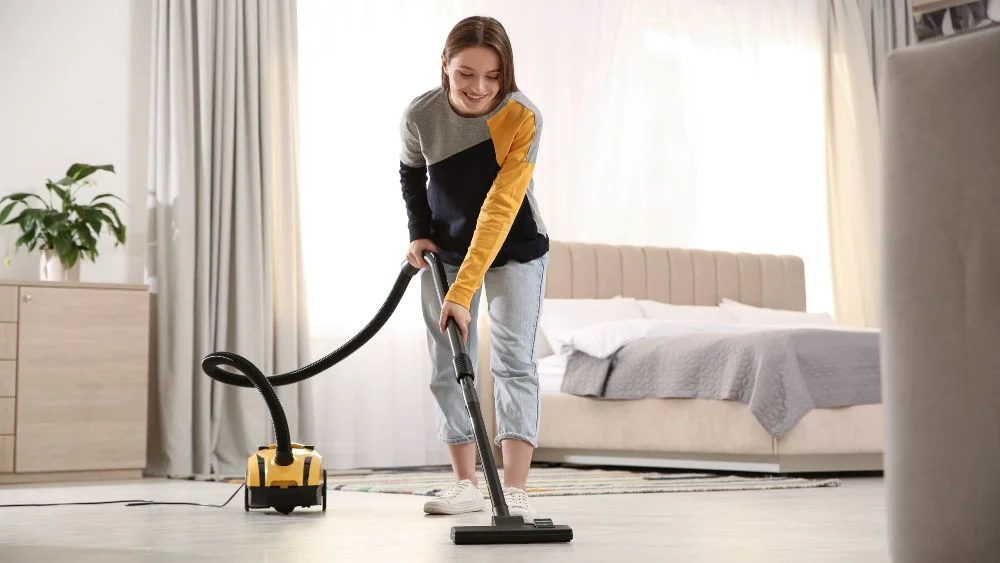
Using a vacuum cleaner is an effective way to eliminate the dust particles around your home. However, some vacuums can actually release more dust and contaminants into the air, which can make your home feel even dustier after cleaning.
To combat this issue, it’s recommended to opt for vacuums equipped with high-efficiency particulate air (HEPA) filtration systems. Alternatively, wet vacuums can be effective as well, as they trap dust in a water container, preventing it from becoming airborne during cleaning.
3. High Humidity Levels
If you reside in a humid area, you are likely to experience more dust in your home compared to those in drier regions. The reason is that dust particles can absorb moisture from the air in humid conditions, causing them to become heavier and settle more readily on surfaces. This can result in a buildup of dust on furniture, floors, and other surfaces within the home. Also, increased moisture in the air creates an ideal environment for mold and dust mites to flourish, leading to higher levels of allergens in the air.
To mitigate this, opt for a dehumidifier to maintain ideal humidity levels in summer. Using air conditioners and dehumidifying plants can also help lower the humidity in your home.
4. Pet Dander
Pet dander consists of tiny skin cells and fur shed by your pets. This dander makes your home dusty; it becomes airborne, mingles with other dust particles, and settles on surfaces. To prevent this issue, ensure routine grooming and brush their fur weekly.
5. Pollen
Pollen can be a major contributor to the dust found inside our homes, especially during the pollen season. It can easily find its way through open doors and windows, sticking to clothing, pets, and indoor plants.
Furthermore, air circulation systems and ventilation can spread pollen throughout the house and even infiltrate through small openings and vents.
To minimize the presence of pollen-related dust kickstarting your allergies, take the following steps: keep doors and windows closed during high pollen seasons, utilize air purifiers, regularly clean and vacuum, wash pets after they’ve been outside, and make sure that your doors and windows have proper seals in place.
6. Dirty Rugs and Carpets
Dirty rugs are like dust magnets, collecting particles like dust, allergens, and more. Even though it might not be feasible to remove carpeting entirely from your home, especially if you’re renting, keeping them clean is essential. Regular vacuuming can help reduce dust.
7. Dusty Drapes and Cushioning
Dusty drapes and upholstery are notorious for collecting dust and allergens over time. But did you know these particles can become airborne with a small disturbance? When you sit on your furniture or open and close your drapes, those accumulated particles take flight and settle on surfaces throughout your home.
To address this issue, consider opting for non-textile window treatments like shutters or blinds. Additionally, it’s advisable to dry-clean curtains more regularly or choose machine-washable options.
8. Drafty Windows
Tiny cracks and gaps in your windows allow outdoor dust and dirt to seep into the home unnoticed. Leaving your windows open for extended periods, especially if you reside near a busy street, can exacerbate this issue by inviting dirt from outside.
Proper sealing and weatherstripping can help prevent drafty windows. This helps create a barrier against outdoor contaminants. Additionally, on windy days when dust, dirt, and pollen are likely to be blown into your home, it’s advisable to keep your windows closed to minimize indoor dust accumulation.
9. Pollution
In urban areas, pollution levels are typically higher due to factors like car exhaust and emissions from factories, creating an environment conducive to increased dust levels. In high-pollution areas, it’s important to minimize outdoor air exposure within your home and ensure that your HVAC system is functioning correctly. Monitor your city’s air quality index to determine when it’s advisable to open your windows for ventilation.
10. Dirt From Outdoors
Whenever you step inside, whether after running errands or just coming home from work, you inevitably bring a bit of the outside world with you.
Placing doormats at entry points can also help trap dirt before it enters your home, and implementing a “no shoes” policy indoors can further minimize the amount of dirt brought inside.
For added convenience, you can set up a changing station near your entryway. This allows household members and guests to easily switch to indoor footwear upon entering, reducing the transfer of outdoor dirt and soil into your living spaces.
11. Leaking Air Ducts
Small openings or cracks in your ductwork allow unwanted dust and debris from unconditioned spaces like attics or crawlspaces to infiltrate your ductwork and spread throughout your house. Thoroughly inspect the ductwork for leaks and seal any gaps you find with a sealant. Additionally, ensuring that your HVAC system is well-maintained and functioning properly can help minimize the spread of dust and maintain good indoor air quality.
Related: AC Ducts Guide for Cleaning and Maintenance
12. Not Cleaning Properly
If you vacuum before dusting your furniture, you are moving a considerable amount of dust from the furniture onto the carpet.
However, if you adopt a top-to-bottom approach, beginning with dusting higher surfaces like ceiling fans, then moving on to washing bedding and dusting lower items such as dressers, and finally, vacuuming the floor, you will effectively remove as much dust as possible.
While dusting, make sure to use the right type of fabric. Traditional dusters or cotton cloth can actually make the problem worse. Instead of picking up the dust, these materials tend to spread it around and send it back into the air. Opt for microfiber cloths instead, which are highly effective at capturing dust particles.
“When it comes to dust removal, using a damp cloth on flat surfaces is more effective than a dry one. This works better since it can catch and hold dust instead of just spreading it around”, says Kerry Sherin, home improvement expert at Ownerly.
13. Skin Dander and Dust Mites
The average person sheds around 1.5 grams of skin flakes every day. This shedding not only contributes to household dust but also provides enough food to sustain millions of dust mites.
Dust mites are tiny insects that can trigger allergies and asthma symptoms in sensitive individuals. They thrive in humid environments where skin cells are shed abundantly, such as bedding, pillows, mattresses, and upholstery. They feed on these skin flakes and thrive in humid environments.
To prevent dust mites from accumulating rapidly, it’s essential to maintain indoor humidity levels between 40% and 50%. This creates an environment that is less hospitable for dust mites to thrive. Additionally, regularly vacuuming your mattress can help remove dust mites and their food source.
Easy Tips to Rid Of Dust In Your Home
Here are some efficient tips on removing excessive dust from your home.
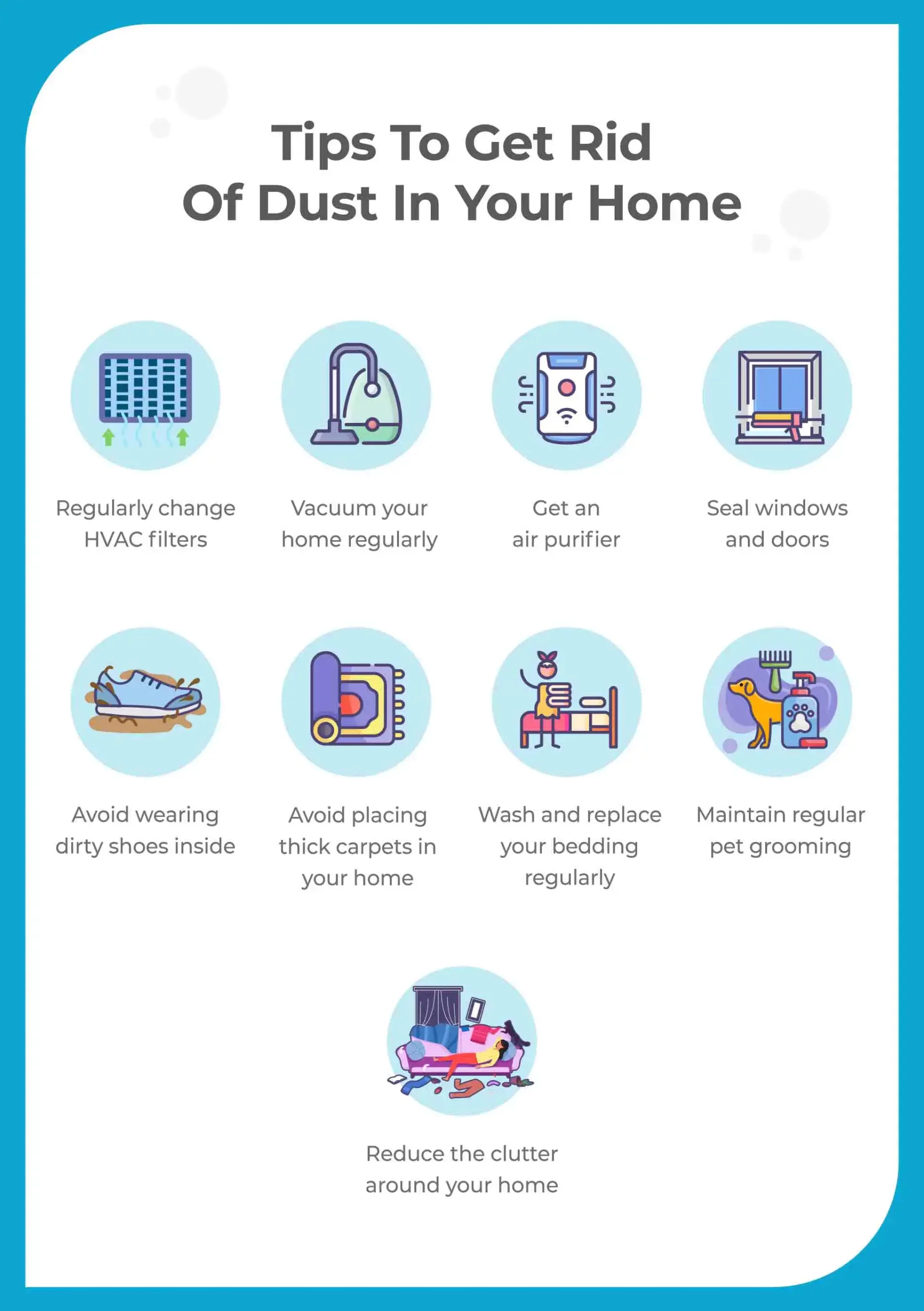
1. Timely Change Your HVAC Filters
To reduce dust accumulation, clean and replace the filters in your HVAC system regularly. Whether you have a central heating and air system or a window unit, if it’s been a while since the filters were changed, it’s likely time for a replacement.
Tony Abate, an indoor air quality expert and Vice President and CTO at AtmosAir, says, “Use pleated filters between 80% and 90% efficiency and replace them every three months to ensure good capture and airflow from your AC.”
If you want a simple solution to keep with your filter maintenance, opt for Cielo smart thermostats for mini-splits. They provide automatic reminder alerts to clean your filters based on your usage.
Your best choice to make any mini-split, window,
or portable AC smart. Enhance your comfort and savings.

2. Vacuum Regularly
You should vacuum twice a week to eliminate all the dust in your carpets, rugs, curtains, and upholstery. Adjust the frequency as needed based on how much dust collects in your home.
Remember to maintain your vacuum cleaner. Ensure it has a HEPA filter that effectively captures dust, allergens, and pollen. If your vacuum has a dirt cup, empty it after each use to maintain maximum suction power. You can also use a vacuum with a dust attachment to get the best results.
Consider purchasing a robot vacuum if your home struggles with significant dust problems or if you have pets. These smart devices can do the job on their own; you just have to program them to run according to your schedule. Plus, they are useful for reaching areas under large or low furniture that traditional vacuums might struggle to reach.
3. Invest In An Air Purifier
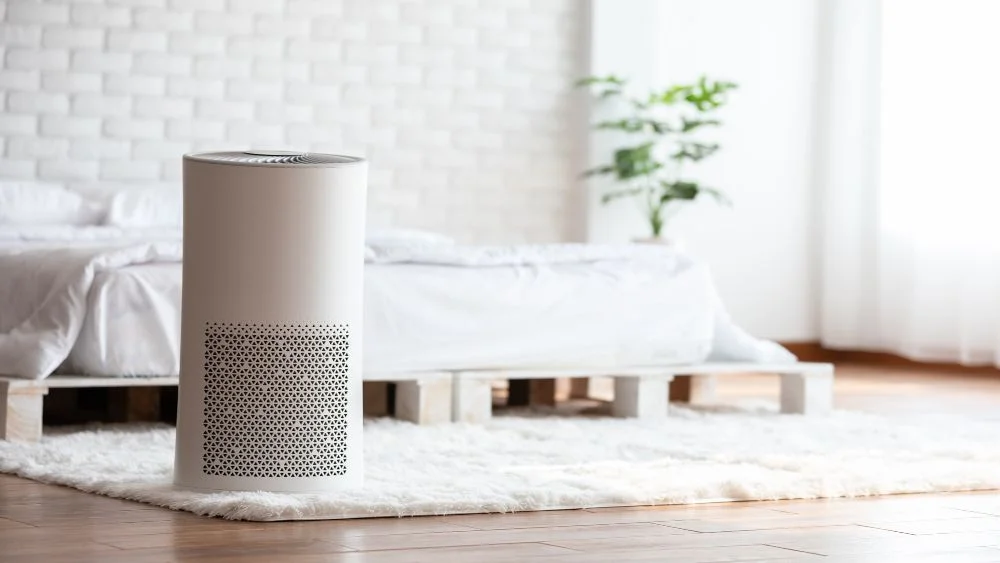
Air purifiers effectively remove airborne pollutants such as dust, pollen, pet dander, smoke, and even harmful viral particles, providing a cleaner and healthier environment to breathe in. By utilizing advanced filtration technologies like HEPA filters, air purifiers can capture even the tiniest particles, ensuring that the air you breathe is free from contaminants. Additionally, air purifiers contribute to reducing the need for frequent cleaning, as they help to minimize dust accumulation on surfaces.
Related: 21 Best Air-Purifying Plants for Your Health and Better Indoor Air Quality
4. Seal the Doors and Windows
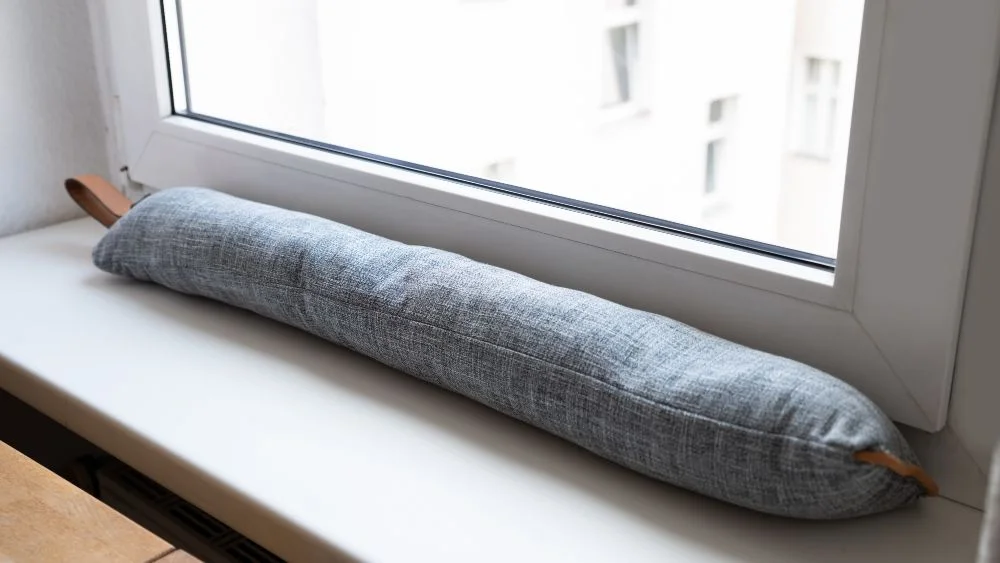
Another great way to prevent outdoor dirt and dust from entering your home is to look for ways to block away any gaps in your windows and doors. Effective sealing methods include weatherstripping, caulking the gaps, and using draft stoppers.
5. Avoid Wearing Outdoor Shoes Inside the House
Dirty shoes are a common way of bringing in dust and debris from outside. Leave your shoes at the door and switch to clean indoor footwear. Using a doormat to wipe your feet before entering can also help minimize dust coming inside. As a general tip, you can place a shoe rack next to your front door to prevent excessive clutter and to store your shoes easily.
6. Remove Carpets From Your House
Carpets can significantly contribute to dust accumulation in your home. Thick rugs, in particular, tend to trap dirt and pollen, making them unsuitable for allergy sufferers. While regular vacuuming can help manage debris, it’s advisable to avoid them.
7. Keep Your Bedding Clean

Remember to clean your bedding and pillowcases and vacuum them regularly to control dust buildup. Pillowcases especially accumulate a lot of dust and dead skin cells. You can use tape or lint removers to lift dust from fabric surfaces.
8. Maintain Regular Pet Grooming

Regular grooming is essential to minimize the spread of fur, dust, and pollen throughout your home. Bathing and combing your pet outdoors on a regular basis can significantly reduce dust accumulation. However, don’t overdo it. It’s important to find a balance, as excessive grooming can dry out your pet’s skin, leading to flakiness and potentially more dust. Consulting with your vet can help you establish the most suitable grooming routine and frequency.
Additionally, it’s a good idea to designate specific areas in your home for your pets, particularly those where you and your furry friends spend the most time, like living rooms and bedrooms. Use washable furniture covers in these areas. These covers act as an extra layer of defense, trapping loose pet hair and dander, which makes cleaning much more manageable.
9. Reduce Clutter
Items such as books, trinkets, or artwork create hiding spots for dust. Furthermore, this can become more problematic if these items are cluttered around your home. Place books at the forefront of shelves to prevent dust buildup. Use plastic bins for storing shoes, purses, and children’s stuffed animals, as they are prone to collecting dust. Display collectibles behind glass to shield them from dust accumulation.
To avoid dust buildup, consider dusting the small items with dryer sheets that have antistatic properties.
Final Takeaway
Accumulation of dust in your home can stem from various factors. Primarily, it’s likely due to a combination of indoor and outdoor elements. Factors such as the location of your house, proximity to roads or construction sites, presence of pets, lack of proper ventilation, and inadequate cleaning habits can all contribute to increased dust levels. Additionally, lifestyle factors like frequent opening of doors and windows without screens or the presence of carpeting and upholstered furniture can also exacerbate dust buildup. To mitigate this issue, implementing regular cleaning routines, investing in air purifiers, sealing windows and doors properly, and minimizing clutter can all help reduce dust levels and create a healthier indoor environment.








